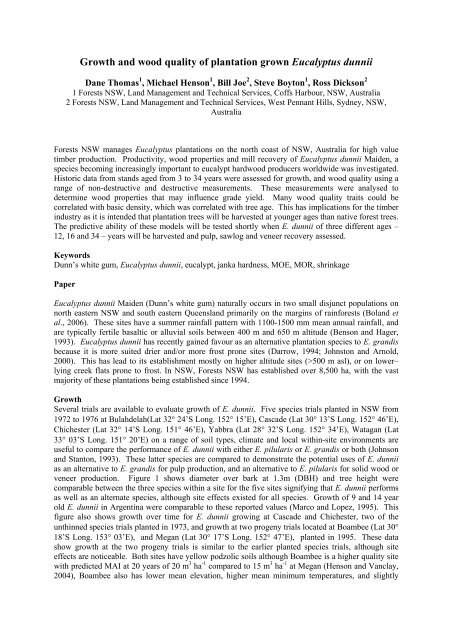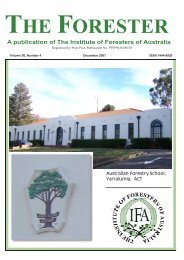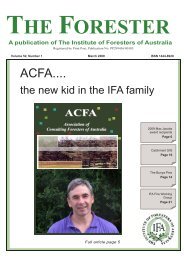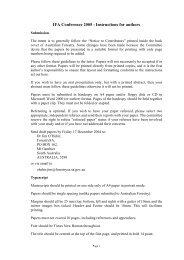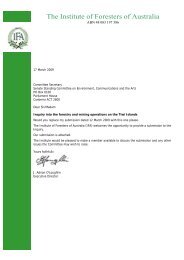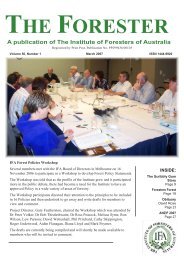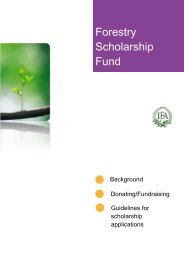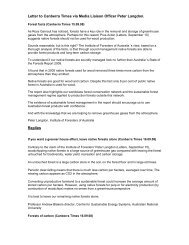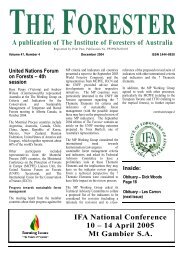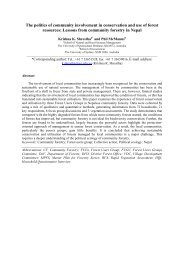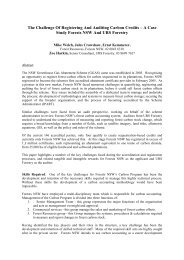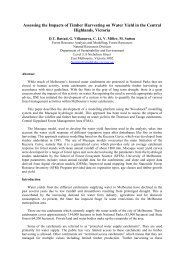Growth and wood quality of plantation grown Eucalyptus dunnii
Growth and wood quality of plantation grown Eucalyptus dunnii
Growth and wood quality of plantation grown Eucalyptus dunnii
You also want an ePaper? Increase the reach of your titles
YUMPU automatically turns print PDFs into web optimized ePapers that Google loves.
<strong>Growth</strong> <strong>and</strong> <strong>wood</strong> <strong>quality</strong> <strong>of</strong> <strong>plantation</strong> <strong>grown</strong> <strong>Eucalyptus</strong> <strong>dunnii</strong><br />
Dane Thomas 1 , Michael Henson 1 , Bill Joe 2 , Steve Boyton 1 , Ross Dickson 2<br />
1 Forests NSW, L<strong>and</strong> Management <strong>and</strong> Technical Services, C<strong>of</strong>fs Harbour, NSW, Australia<br />
2 Forests NSW, L<strong>and</strong> Management <strong>and</strong> Technical Services, West Pennant Hills, Sydney, NSW,<br />
Australia<br />
Forests NSW manages <strong>Eucalyptus</strong> <strong>plantation</strong>s on the north coast <strong>of</strong> NSW, Australia for high value<br />
timber production. Productivity, <strong>wood</strong> properties <strong>and</strong> mill recovery <strong>of</strong> <strong>Eucalyptus</strong> <strong>dunnii</strong> Maiden, a<br />
species becoming increasingly important to eucalypt hard<strong>wood</strong> producers worldwide was investigated.<br />
Historic data from st<strong>and</strong>s aged from 3 to 34 years were assessed for growth, <strong>and</strong> <strong>wood</strong> <strong>quality</strong> using a<br />
range <strong>of</strong> non-destructive <strong>and</strong> destructive measurements. These measurements were analysed to<br />
determine <strong>wood</strong> properties that may influence grade yield. Many <strong>wood</strong> <strong>quality</strong> traits could be<br />
correlated with basic density, which was correlated with tree age. This has implications for the timber<br />
industry as it is intended that <strong>plantation</strong> trees will be harvested at younger ages than native forest trees.<br />
The predictive ability <strong>of</strong> these models will be tested shortly when E. <strong>dunnii</strong> <strong>of</strong> three different ages –<br />
12, 16 <strong>and</strong> 34 – years will be harvested <strong>and</strong> pulp, sawlog <strong>and</strong> veneer recovery assessed.<br />
Keywords<br />
Dunn’s white gum, <strong>Eucalyptus</strong> <strong>dunnii</strong>, eucalypt, janka hardness, MOE, MOR, shrinkage<br />
Paper<br />
<strong>Eucalyptus</strong> <strong>dunnii</strong> Maiden (Dunn’s white gum) naturally occurs in two small disjunct populations on<br />
north eastern NSW <strong>and</strong> south eastern Queensl<strong>and</strong> primarily on the margins <strong>of</strong> rainforests (Bol<strong>and</strong> et<br />
al., 2006). These sites have a summer rainfall pattern with 1100-1500 mm mean annual rainfall, <strong>and</strong><br />
are typically fertile basaltic or alluvial soils between 400 m <strong>and</strong> 650 m altitude (Benson <strong>and</strong> Hager,<br />
1993). <strong>Eucalyptus</strong> <strong>dunnii</strong> has recently gained favour as an alternative <strong>plantation</strong> species to E. gr<strong>and</strong>is<br />
because it is more suited drier <strong>and</strong>/or more frost prone sites (Darrow, 1994; Johnston <strong>and</strong> Arnold,<br />
2000). This has lead to its establishment mostly on higher altitude sites (>500 m asl), or on lower–<br />
lying creek flats prone to frost. In NSW, Forests NSW has established over 8,500 ha, with the vast<br />
majority <strong>of</strong> these <strong>plantation</strong>s being established since 1994.<br />
<strong>Growth</strong><br />
Several trials are available to evaluate growth <strong>of</strong> E. <strong>dunnii</strong>. Five species trials planted in NSW from<br />
1972 to 1976 at Bulahdelah(Lat 32° 24’S Long. 152° 15’E), Cascade (Lat 30° 13’S Long. 152° 46’E),<br />
Chichester (Lat 32° 14’S Long. 151° 46’E), Yabbra (Lat 28° 32’S Long. 152° 34’E), Watagan (Lat<br />
33° 03’S Long. 151° 20’E) on a range <strong>of</strong> soil types, climate <strong>and</strong> local within-site environments are<br />
useful to compare the performance <strong>of</strong> E. <strong>dunnii</strong> with either E. pilularis or E. gr<strong>and</strong>is or both (Johnson<br />
<strong>and</strong> Stanton, 1993). These latter species are compared to demonstrate the potential uses <strong>of</strong> E. <strong>dunnii</strong><br />
as an alternative to E. gr<strong>and</strong>is for pulp production, <strong>and</strong> an alternative to E. pilularis for solid <strong>wood</strong> or<br />
veneer production. Figure 1 shows diameter over bark at 1.3m (DBH) <strong>and</strong> tree height were<br />
comparable between the three species within a site for the five sites signifying that E. <strong>dunnii</strong> performs<br />
as well as an alternate species, although site effects existed for all species. <strong>Growth</strong> <strong>of</strong> 9 <strong>and</strong> 14 year<br />
old E. <strong>dunnii</strong> in Argentina were comparable to these reported values (Marco <strong>and</strong> Lopez, 1995). This<br />
figure also shows growth over time for E. <strong>dunnii</strong> growing at Cascade <strong>and</strong> Chichester, two <strong>of</strong> the<br />
unthinned species trials planted in 1973, <strong>and</strong> growth at two progeny trials located at Boambee (Lat 30°<br />
18’S Long. 153° 03’E), <strong>and</strong> Megan (Lat 30° 17’S Long. 152° 47’E), planted in 1995. These data<br />
show growth at the two progeny trials is similar to the earlier planted species trials, although site<br />
effects are noticeable. Both sites have yellow podzolic soils although Boambee is a higher <strong>quality</strong> site<br />
with predicted MAI at 20 years <strong>of</strong> 20 m 3 ha -1 compared to 15 m 3 ha -1 at Megan (Henson <strong>and</strong> Vanclay,<br />
2004), Boambee also has lower mean elevation, higher mean minimum temperatures, <strong>and</strong> slightly
higher rainfall than Megan. The Boambee <strong>and</strong> Megan progeny trials were thinned from 1388 s.p.h. to<br />
694 at age 4.5 year. The Boambee progeny trial is due to be thinned to 347 s.p.h. later this year.<br />
Despite the acceptable growth performance <strong>of</strong> E. <strong>dunnii</strong> measured as diameter, height, or volume this<br />
‘growth’ is only one attribute <strong>of</strong> timber. The end use <strong>of</strong> the timber also has to be considered. The<br />
Boambee trial will be used to assess solid, veneer <strong>and</strong> pulp <strong>wood</strong> properties <strong>of</strong> this high performing<br />
younger st<strong>and</strong> at age 12 years. Two other sites aged 16 <strong>and</strong> 34 years will also be harvested <strong>and</strong> similar<br />
end uses evaluated. Non-destructive measurements associated with <strong>wood</strong> <strong>quality</strong> traits have been<br />
evaluated on these trials at earlier ages.<br />
Diameter breast height (cm)<br />
Tree height (m)<br />
40<br />
35<br />
30<br />
25<br />
20<br />
15<br />
10<br />
5<br />
0<br />
40<br />
35<br />
30<br />
25<br />
20<br />
15<br />
10<br />
5<br />
0<br />
0 5 10 15 20 25 30 35<br />
Age (years)<br />
0 5 10 15 20 25 30 35<br />
Age (years)<br />
E. <strong>dunnii</strong><br />
E. gr<strong>and</strong>is<br />
E. pilularis<br />
Cascade<br />
Chichester<br />
Boambee<br />
Megan<br />
E. <strong>dunnii</strong><br />
E. gr<strong>and</strong>is<br />
E. pilularis<br />
Cascade<br />
Chichester<br />
Boambee<br />
Megan<br />
Figure 1. Mean diameter over bark at 1.3m (DBH) <strong>and</strong> mean tree height at last formal measurement <strong>of</strong> E.<br />
<strong>dunnii</strong> (open square), E. gr<strong>and</strong>is (open triangle) <strong>and</strong> E. pilularis (open circle) from 5 ‘species’ trials. Mean<br />
tree growth <strong>of</strong> E. <strong>dunnii</strong> over time for two <strong>of</strong> these trials at Cascade (solid square) <strong>and</strong> Chichester (solid<br />
diamond) are shown. Additionally mean growth at two E. <strong>dunnii</strong> progeny trials at Boambee (solid triangle)<br />
<strong>and</strong> Megan (solid circle) are shown.<br />
Density<br />
Wood density is <strong>of</strong>ten used to characterise <strong>wood</strong> because it is correlated, although perhaps not always<br />
causally related, with many <strong>quality</strong> traits. Denser <strong>wood</strong> tends to be stronger but may have higher<br />
shrinkage <strong>and</strong> more checks in dried <strong>wood</strong>. Denser <strong>wood</strong> contains more <strong>wood</strong> per unit volume thus it
tends to give higher yield <strong>of</strong> pulp in paper manufacturing. Thus information about <strong>wood</strong> density is<br />
useful to <strong>plantation</strong> management.<br />
Density typically increases with tree age as the proportion <strong>of</strong> lower density material formed early in<br />
the trees life is reduced by the higher density material formed in older trees (eg. de Silva et al., 2004).<br />
Basic density <strong>of</strong> native forest E. <strong>dunnii</strong> is reported to be 610 kg m -3 (Bootle, 2005). These data are<br />
probably from mature native forest st<strong>and</strong>s. Data from a combination <strong>of</strong> basic density <strong>of</strong> 12 mm<br />
diametric (bark to bark) cores, whole disks at DBH, <strong>and</strong> estimation <strong>of</strong> whole tree density were used to<br />
develop a relationship with tree age for NSW <strong>plantation</strong> material. Density <strong>of</strong> <strong>plantation</strong> <strong>grown</strong><br />
material from NSW <strong>and</strong> elsewhere shows there is a trend <strong>of</strong> increasing basic density in older trees to<br />
approximately 600 kg m -3 at 25 years although there is some variability with method <strong>of</strong> sampling<br />
<strong>and</strong>/or site with non NSW sites (predominantly South American) (Ribeiro <strong>and</strong> Filho, 1993, Marco <strong>and</strong><br />
Lopez, 1995; Calori <strong>and</strong> Kikuti, 1997; Ferriera et al., 1997; Backman <strong>and</strong> deLeon, 1998; Dickson et<br />
al., 2003; Arnold et al., 2004; Henson et al., 2004; Muneri et al., 2007) (Figure 2). Mature native<br />
forest tree age was assumed to be 34 years (although is probably older) for no other reason but to<br />
graphically present the data provided by Bootle (2005). The relationship between tree age <strong>and</strong> density<br />
<strong>of</strong> NSW <strong>plantation</strong> E. <strong>dunnii</strong> had a high correlation coefficient <strong>of</strong> 0.91, n=9.<br />
Density can be “predicted” non-destructively from pilodyn penetration. Relationships between pilodyn<br />
<strong>and</strong> density <strong>of</strong> whole tree <strong>and</strong> <strong>wood</strong> disk at breast height were developed for NSW <strong>plantation</strong>s. A<br />
relationship with whole tree density was developed from two sites aged 8 years using 4 pilodyn<br />
measurements per tree at breast height <strong>and</strong> whole tree density averaged from 6 disks collected at<br />
heights ranging from 0.3 m to 90% tree height (Henson, unpublished data). A further relationship was<br />
developed for density <strong>of</strong> a <strong>wood</strong> disk at breast height from 9 year data collected at one site using 47<br />
family mean values <strong>of</strong> one pilodyn reading per tree <strong>and</strong> an average <strong>of</strong> 4 trees per family. These<br />
relationships allowed predictions <strong>of</strong> basic density <strong>of</strong> NSW <strong>plantation</strong>s aged 11, 16 <strong>and</strong> 32 years to be<br />
540, 530 <strong>and</strong> 563 kg m -3 respectively. Predicted basic density at these ages show these E. <strong>dunnii</strong> are<br />
similar to other reported values <strong>and</strong> fall on the general age based relationship developed earlier (Figure<br />
2).<br />
Basic density (kg m-3)<br />
700<br />
600<br />
500<br />
400<br />
300<br />
200<br />
100<br />
0<br />
R 2 = 0.91 n=9<br />
0 5 10 15 20 25 30 35<br />
Age (years)<br />
Tree<br />
Disk<br />
Core<br />
Non NSW<br />
Predicted<br />
NSW<br />
Mature<br />
Log. (NSW)<br />
Figure 2. Basic density <strong>of</strong> E. <strong>dunnii</strong> as a function <strong>of</strong> tree age. NSW <strong>plantation</strong> data are shown in blue with<br />
density calculated from whole tree (solid diamond), calculated from disks (solid circle), <strong>wood</strong> cores (solid<br />
square). The regression relationship uses these data. Non-NSW data are shown as solid triangles. Density <strong>of</strong><br />
NSW <strong>plantation</strong>s aged 12, 16 <strong>and</strong> 32 years predicted using pilodyn relationships are shown as open circles.<br />
Density <strong>of</strong> mature native forest trees are shown as large solid circle, <strong>and</strong> an age <strong>of</strong> 34 years was selected for<br />
ease <strong>of</strong> graphic display.
Pulp characteristics<br />
Pulp characteristics <strong>of</strong> E. <strong>dunnii</strong> have been evaluated at age 8 years at Megan <strong>and</strong> Boambee, <strong>and</strong> at age<br />
9 years at Boambee. Boambee is a higher <strong>quality</strong> site than Megan resulting in approximately twice the<br />
height <strong>and</strong> diameter growth (Figure 1) <strong>and</strong> 4 times the volume growth at age 9. Boambee trees were<br />
easier to pulp, required 12.8% active alkali, produced 53% screened pulp <strong>and</strong> had a higher pulp yield<br />
<strong>of</strong> 277 kg m -3 compared to 13.8% active alkali, 50% screened pulp, <strong>and</strong> 237 kg m -3 pulp yield at<br />
Megan (Muneri et al., 2007). The Boambee results are comparable to both 9 year old E. <strong>dunnii</strong> <strong>grown</strong><br />
in South Africa (Clark <strong>and</strong> Hicks, 2003) <strong>and</strong> 4 year old trees <strong>grown</strong> in South America (Backman <strong>and</strong><br />
deLeon, 1998). The smaller fibre length at Megan <strong>of</strong> 0.74 mm was similar to the Clarks (1995)<br />
results, which were both shorter than the average fibre lengths <strong>of</strong> 0.86 mm at Boambee. These data<br />
show site <strong>quality</strong> can impact on pulp yield <strong>and</strong> <strong>quality</strong>. Silvicultural practices such as stocking can<br />
also impact on pulp productivity <strong>of</strong> E. <strong>dunnii</strong> (Ferreira et al., 1997) through, amongst other factors,<br />
changes in pulping characteristics, tree diameter <strong>and</strong> height growth, <strong>and</strong> <strong>wood</strong> density.<br />
Basic density <strong>and</strong> pulp yield <strong>of</strong> 8 year old E. <strong>dunnii</strong> growing at Boambee <strong>and</strong> Megan <strong>plantation</strong>s were<br />
recently estimated using Near Infrared spectroscopy (Muneri et al., 2004). This technique <strong>of</strong>fers fast<br />
cost effective evaluation <strong>of</strong> economic potential <strong>of</strong> trees. The predicted values were within 2% <strong>of</strong><br />
observed values, with high correlation coefficients. These relationships will be tested on other sites<br />
<strong>and</strong> older trees to determine the effectiveness <strong>of</strong> these relationships.<br />
Solid Wood<br />
<strong>Growth</strong> stresses<br />
Solid <strong>wood</strong> properties <strong>of</strong> E. <strong>dunnii</strong> are in many ways more difficult to ascertain than density or pulping<br />
characteristics. One common problem <strong>of</strong> <strong>plantation</strong>-<strong>grown</strong> <strong>wood</strong> as opposed to native forest sourced<br />
material is related to growth stresses. <strong>Growth</strong> stresses are little understood but are thought to be<br />
related to the growth rate <strong>of</strong> trees <strong>and</strong> <strong>of</strong>ten decline with tree age. Peripheral growth stresses in 9 year<br />
old E. <strong>dunnii</strong> <strong>grown</strong> at Boambee were evaluated recently (Murphy et al., 2005). <strong>Growth</strong> stresses were<br />
found to be heritable, but it was also observed that taller thinner trees had more growth stress than<br />
short thick trees (Murphy et al., 2005) suggesting stresses may be altered by site <strong>and</strong> silvicultural<br />
management influences on stem taper.<br />
<strong>Growth</strong> stresses are a major concern when processing timber. It has been estimated that one third <strong>of</strong><br />
sawn material from <strong>plantation</strong> <strong>grown</strong> E. <strong>dunnii</strong> may suffer degrade attributable to growth stress (Matos<br />
et al., 2003). Similar degrade was reported in 10 year old <strong>plantation</strong> <strong>grown</strong> E. globulus where 30% <strong>of</strong><br />
boards were ejected due to excessive distortion <strong>and</strong> 40% <strong>of</strong> this distortion could be attributed to<br />
growth stress (Yang et al., 2001, 2002). It is therefore not surprising that methods have been examined<br />
to reduce losses due to growth stress. Alternate sawing techniques are used to increase recoveries.<br />
Additionally various methods have been used to reduce <strong>and</strong> release growth stresses prior to harvest<br />
(Malan, 1995). Techniques such as girdling <strong>of</strong> st<strong>and</strong>ing trees, or partial defoliation prior to harvest<br />
were shown to reduce growth stresses <strong>of</strong> E. gr<strong>and</strong>is although the variation between trees <strong>and</strong> excessive<br />
decay <strong>of</strong> girdled trees was excessive (Malan, 1995). Herbicide <strong>and</strong> radial cuts were most effective in<br />
reducing growth stresses <strong>of</strong> E. <strong>dunnii</strong> (Matos et al., 2003). Post- harvest steaming treatments prior to<br />
milling were also effective in reducing splitting <strong>and</strong> other growth stress related defects in E. <strong>dunnii</strong><br />
(Severo <strong>and</strong> Tomaselli, 2000).<br />
Shrinkage <strong>and</strong> collapse<br />
Shrinkage <strong>of</strong> <strong>wood</strong> is a further <strong>quality</strong> attribute with some correlation with growth stress. Ten year<br />
old E. nitens with low growth stress had less shrinkage (Chauhan <strong>and</strong> Walker, 2004), while Yang <strong>and</strong><br />
Pongracic (2004) found a weak negative relationship between tangential shrinkage <strong>and</strong> growth stress<br />
<strong>of</strong> ten year old E. globulus. A strong relationship existed between growth stress <strong>and</strong> the difference in<br />
shrinkage between heart<strong>wood</strong> <strong>and</strong> sap<strong>wood</strong> <strong>of</strong> E. nitens (Chauhan <strong>and</strong> Walker, 2004). Shrinkage <strong>of</strong> E.<br />
globulus sap<strong>wood</strong> was typically low at about half that <strong>of</strong> outer heart<strong>wood</strong> (Yang <strong>and</strong> Pongracic, 2004).<br />
It is clear the relationship between growth stress <strong>and</strong> shrinkage requires further research.<br />
Bootle (2005) lists tangential shrinkage <strong>of</strong> mature native forest E. <strong>dunnii</strong> <strong>of</strong> an unknown age to be 10%<br />
<strong>and</strong> radial shrinkage at 5%, giving a ratio between tangential <strong>and</strong> radial shrinkage <strong>of</strong> 2.0. Lower<br />
shrinkage ratios are desirable as cupping <strong>of</strong> boards during drying would be reduced with more uniform
shrinkage ratios. Older <strong>plantation</strong> <strong>grown</strong> E. <strong>dunnii</strong> have comparable shrinkage to mature trees noted in<br />
Bootle (2005). Tangential shrinkage <strong>of</strong> 10.2% <strong>and</strong> radial shrinkage <strong>of</strong> 6.2% were found in 20 year old<br />
Brazilian <strong>plantation</strong> E. <strong>dunnii</strong>, giving a lower ratio between tangential shrinkage <strong>and</strong> radial shrinkage<br />
<strong>of</strong> almost 1.5 (Calori <strong>and</strong> Kikuti, 1997). Shrinkage after re-conditioning to recover collapse <strong>of</strong> 29<br />
year old E. <strong>dunnii</strong> at Chichester, NSW was 8.4% tangentially <strong>and</strong> 3.2% radially (Joe, unpublished<br />
data), while shrinkage after re-conditioning to recover collapse <strong>of</strong> 6 year old E. <strong>dunnii</strong> was 6.2%<br />
tangentially <strong>and</strong> 2.2% radially (Joe, unpublished data). These shrinkage values are less than the<br />
Brazilian trees, but in each case the ratio between tangential <strong>and</strong> radial shrinkage was higher at 2.6 for<br />
the 29 year material <strong>and</strong> 2.8 for the 6 year old material. Collapse in the NSW <strong>plantation</strong> material<br />
accounted for about 4% <strong>of</strong> the un-recovered tangential shrinkage but less than 1% <strong>of</strong> the radial<br />
shrinkage (Joe, unpublished). Recovery <strong>of</strong> this collapse could lead to checking <strong>and</strong> be detrimental to<br />
appearance grade products (Har<strong>wood</strong> et al., 2005).<br />
Shrinkage in 9 year old age <strong>plantation</strong>-<strong>grown</strong> E. <strong>dunnii</strong> from NSW has also been examined on 12 mm<br />
diametric (bark to bark) pseudo cores (B<strong>and</strong>ara, 2006). Tangential shrinkage was 7.1% while collapse<br />
was found to be 10% (B<strong>and</strong>ara, 2006). No data are available <strong>of</strong> radial variation in these shrinkage or<br />
collapse values. However, Henson et al., (2004) report tangential <strong>and</strong> radial shrinkage <strong>of</strong> boards<br />
obtained from this material <strong>and</strong> dried quickly to exacerbate distortion to be 11.7% <strong>and</strong> 3.1%<br />
respectively. This corresponds to a ratio <strong>of</strong> tangential to radial shrinkage <strong>of</strong> 3.8, a value higher than in<br />
other reports.<br />
The high ratio <strong>of</strong> tangential to radial shrinkage for NSW <strong>plantation</strong>s is <strong>of</strong> concern as sawn material<br />
will be under differential stresses while drying, which may lead to drying related defects such as<br />
cupping (Har<strong>wood</strong> et al., 2005). Har<strong>wood</strong> et al. (2005) <strong>and</strong> B<strong>and</strong>ara (2006) noted a high percentage<br />
<strong>of</strong> boards sawn from 9 year old material displayed cupping after drying. Following reconditioning<br />
27% <strong>of</strong> these boards had unrecoverable collapse (shrinkage) related defects on an average <strong>of</strong> 60% <strong>of</strong><br />
their length, while surface checking was visible on less than 0.1% <strong>of</strong> the board length (Har<strong>wood</strong> et al.<br />
2005; B<strong>and</strong>ara, 2006).<br />
It is interesting to note that the higher ratio <strong>of</strong> tangential to radial shrinkage in NSW <strong>plantation</strong><br />
material is different to both the older native forest resource <strong>and</strong> the 20 year old Brazilian <strong>plantation</strong><br />
material. This suggests this difference is not solely related to age <strong>of</strong> the material. The higher ratio in<br />
the NSW <strong>plantation</strong> material is due more to proportionally much lower radial shrinkage in the NSW<br />
<strong>plantation</strong> material than to differences in tangential shrinkage between the two sources <strong>of</strong> trees.<br />
Differential transverse shrinkage can be due to many factors including gross anatomical structures<br />
such as cell lumen size or cell wall thickness, or presence <strong>of</strong> <strong>wood</strong> rays, or more detailed structure<br />
such as cell wall micr<strong>of</strong>ibril angle, or composition <strong>of</strong> the middle lamella (Kollman <strong>and</strong> Cote, 1977).<br />
Clearly the higher ratio <strong>of</strong> tangential shrinkage to radial shrinkage <strong>of</strong> NSW <strong>plantation</strong> <strong>grown</strong> E. <strong>dunnii</strong><br />
needs to be addressed. Gains could be made through greater use <strong>of</strong> improved genetic material as it has<br />
been shown that <strong>wood</strong> traits are highly heritable, <strong>and</strong> that for E. pilularis tangential <strong>and</strong> radial<br />
shrinkage <strong>and</strong> their ratio is under genetic control (Pelletier, 2006; Henson Pers Comm).<br />
A simple regression between basic density <strong>and</strong> tangential shrinkage <strong>of</strong> mean values for the 3 NSW<br />
<strong>plantation</strong>-<strong>grown</strong> E. <strong>dunnii</strong> gave a positive relationship (Figure 3). This is not unexpected as others<br />
(eg. Kollman <strong>and</strong> Cote, 1977; West, 2006) have noted that the thicker cell walls <strong>of</strong> denser <strong>wood</strong> tend<br />
to contain larger amounts <strong>of</strong> water than cells <strong>of</strong> less dense <strong>wood</strong>, which makes denser <strong>wood</strong> subject to<br />
more shrinkage. The corresponding values for mature trees provided by Bootle (2005) agree with the<br />
correlation developed using NSW <strong>plantation</strong> <strong>grown</strong> E. <strong>dunnii</strong>.
Tangential shrinkage (%)<br />
12<br />
10<br />
8<br />
6<br />
4<br />
2<br />
R 2 = 0.9997 n=3<br />
0<br />
300 400 500 600 700<br />
Basic density (kg m-3)<br />
NSW<br />
Mature<br />
Non NSW<br />
Linear (NSW)<br />
Figure 3. Tangential shrinkage after re-conditioning <strong>of</strong> <strong>plantation</strong> <strong>grown</strong> E. <strong>dunnii</strong> as a function <strong>of</strong> basic<br />
density. Means <strong>of</strong> three experiments using NSW <strong>plantation</strong> material <strong>of</strong> different ages (solid square). The<br />
regression relationship uses these three data. Non-NSW data are shown as solid triangle. Mature native forest<br />
tree are shown as solid circle.<br />
Mechanical Properties<br />
Hardness, modulus <strong>of</strong> rupture (MOR) <strong>and</strong> modulus <strong>of</strong> elasticity (MOE) are the principal mechanical<br />
properties dictating uses <strong>of</strong> solid <strong>wood</strong>.<br />
Hardness<br />
Wood hardness is a measure <strong>of</strong> resistance to indentation, <strong>and</strong> provides an indication to how well the<br />
<strong>wood</strong> performs to wear <strong>and</strong> marking. It is an important <strong>quality</strong> trait for flooring <strong>and</strong> furniture, <strong>and</strong> is<br />
less important for other solid <strong>wood</strong> products. Phenotypic correlations between hardness <strong>and</strong> density <strong>of</strong><br />
eucalypts including E. <strong>dunnii</strong> have been shown to be positive (eg. Dickson et al., 2003). The<br />
regression <strong>of</strong> hardness <strong>and</strong> density, <strong>and</strong> hardness <strong>and</strong> tree age using site means <strong>of</strong> NSW <strong>plantation</strong><br />
<strong>grown</strong> E. <strong>dunnii</strong> were positive (Figure 4). Data from mature E. <strong>dunnii</strong> <strong>and</strong> E. <strong>dunnii</strong> <strong>grown</strong> in Brazil<br />
agree with these relationships, suggesting hardness will increase with <strong>plantation</strong> age because density<br />
will increase with <strong>plantation</strong> age. Predicted hardness for other NSW E. <strong>dunnii</strong> <strong>plantation</strong>s aged 12, 16<br />
<strong>and</strong> 32 years are shown. Basic densities <strong>of</strong> these trials were predicted from relationships between<br />
pilodyn <strong>and</strong> density.
Hardness<br />
Hardness<br />
8<br />
7<br />
6<br />
5<br />
4<br />
3<br />
2<br />
1<br />
0<br />
8<br />
7<br />
6<br />
5<br />
4<br />
3<br />
2<br />
1<br />
0<br />
R 2 = 0.90 n=5<br />
0 5 10 15 20 25 30 35<br />
Age (years)<br />
R 2 = 0.94 n=5<br />
300 400 500 600 700<br />
Basic density (kg m-3)<br />
NSW<br />
Mature<br />
Non NSW<br />
Predicted from Density<br />
Linear (NSW)<br />
NSW<br />
Mature<br />
Non NSW<br />
Predicted from Age<br />
Linear (NSW)<br />
Figure 4. Hardness <strong>of</strong> E. <strong>dunnii</strong> as a function <strong>of</strong> basic density <strong>and</strong> <strong>of</strong> age. NSW <strong>plantation</strong> material are shown<br />
as solid square <strong>and</strong> the regression equation was calculated using these data. Non-NSW data are shown as<br />
solid triangle. Mature native forest tree are shown as large solid circle, <strong>and</strong> an age <strong>of</strong> 34 years was selected<br />
for ease <strong>of</strong> graphic display. Hardness predicted for 3 <strong>plantation</strong>s using the relationship with density are shown<br />
as open circles, while hardness predicted from the relationship with <strong>plantation</strong> age are shown by open squares.<br />
Modulus <strong>of</strong> Rupture, Modulus <strong>of</strong> Elasticity<br />
Modulus <strong>of</strong> rupture was found to be related to density <strong>and</strong> to age in <strong>plantation</strong>-<strong>grown</strong> E. <strong>dunnii</strong> (Figure<br />
5). Both relationships were positive with correlation coefficients greater than 0.9 for the relationship<br />
with basic density <strong>and</strong> 0.67 for the relationship with tree age. The data for mature native forest<br />
sourced E. <strong>dunnii</strong> was similar to experimental data (Bootle, 2005).
MOR (MPa)<br />
MOR (MPa)<br />
160<br />
140<br />
120<br />
100<br />
80<br />
60<br />
40<br />
20<br />
0<br />
160<br />
140<br />
120<br />
100<br />
80<br />
60<br />
40<br />
20<br />
0<br />
R 2 = 0.67 n=5<br />
0 5 10 15 20 25 30 35<br />
Age (years)<br />
R 2 = 0.91 n=5<br />
300 400 500 600 700<br />
Basic density (kg m-3)<br />
NSW<br />
Mature<br />
Predicted from Density<br />
Linear (NSW)<br />
NSW<br />
Mature<br />
Predicted from Age<br />
Linear (NSW)<br />
Figure 5. Modulus <strong>of</strong> rupture (MOR) <strong>of</strong> E. <strong>dunnii</strong> as a function <strong>of</strong> basic density <strong>and</strong> <strong>of</strong> age. NSW <strong>plantation</strong><br />
material are shown as solid square <strong>and</strong> the regression equation was calculated using these data. Mature native<br />
forest tree are shown as large solid circle, <strong>and</strong> an age <strong>of</strong> 34 years was selected for ease <strong>of</strong> graphic display.<br />
Predicted MORs for 3 <strong>plantation</strong>s aged 12, 16 <strong>and</strong> 32 years using the relationship with density are shown as<br />
open circles, while MORs predicted from the relationship with <strong>plantation</strong> age are shown by open squares.<br />
Modulus <strong>of</strong> elasticity measures stiffness <strong>of</strong> <strong>wood</strong>. It is less <strong>of</strong> a problem with hard<strong>wood</strong>s than pine<br />
although juvenile <strong>wood</strong> from <strong>plantation</strong>s may potentially have unacceptable MOE. MOE increased<br />
with density in five NSW <strong>plantation</strong> E. <strong>dunnii</strong>, while the relationship with tree age was less accurate<br />
(Figure 6). The linear relationships <strong>of</strong> tree age or basic density with both MOE <strong>and</strong> MOR may not be<br />
the most appropriate relationship as logarithmic functions could also be used. In both cases the data<br />
show both MOR <strong>and</strong> MOE increase over time, <strong>and</strong> that neither tree age nor basic density is a wholly<br />
satisfactory explanatory variable (except in the case <strong>of</strong> the MOR basic density relationship). MOE is<br />
influenced by density <strong>and</strong> micr<strong>of</strong>ibril angle, with micr<strong>of</strong>ibril angle accounting for more variation than<br />
density (Evans <strong>and</strong> Ilic, 2000; Yang <strong>and</strong> Evans, 2003). In combination, density <strong>and</strong> micr<strong>of</strong>ibril angle<br />
can account for over 90% <strong>of</strong> MOE in <strong>plantation</strong> eucalypts (Evans <strong>and</strong> Ilic, 2000; Yang <strong>and</strong> Evans,<br />
2003). The relationship between MOE <strong>and</strong> density <strong>of</strong> mature native forest E. <strong>dunnii</strong> differs from the<br />
relationship developed using <strong>plantation</strong> E. <strong>dunnii</strong> (Figure 6). MOE <strong>of</strong> mature E. <strong>dunnii</strong> was higher<br />
than predicted using <strong>plantation</strong> E. <strong>dunnii</strong> despite similar basic density (Figure 6). As micr<strong>of</strong>ibril angle<br />
typically declines with tree age (eg. Lindstrőm et al. 1998), <strong>and</strong> as large gains in MOE are realized<br />
with relatively small changes in micr<strong>of</strong>ibril angle (eg Yang <strong>and</strong> Evans, 2003), it seems likely that
MOE <strong>of</strong> mature native forest material is likely to be more heavily influenced by lower micr<strong>of</strong>ibril<br />
angle than younger <strong>plantation</strong> material, despite similar basic densities.<br />
MOE can also be predicted from acoustic measurements such as FAKOPP. Of three acoustic<br />
instruments tested, Henson et al. (2004) found FAKOPP gave the most accurate predictions <strong>of</strong> MOE.<br />
Predicted MOE <strong>of</strong> older E. <strong>dunnii</strong> <strong>plantation</strong>s using a linear relationship between MOE <strong>and</strong> FAKOPP<br />
showed MOE to be greater than 14 GPa in st<strong>and</strong>s aged 12 years or older.<br />
MOE (GPa)<br />
MOE (GPa)<br />
25<br />
20<br />
15<br />
10<br />
25<br />
20<br />
15<br />
10<br />
5<br />
0<br />
5<br />
0<br />
R 2 = 0.36 n=5<br />
0 5 10 15 20 25 30 35<br />
Age (years)<br />
R 2 = 0.63 n=5<br />
300 400 500 600 700<br />
Basic density (kg m-3)<br />
NSW<br />
Mature<br />
Predicted from Density<br />
Predicted from FAKOPP<br />
Linear (NSW)<br />
NSW<br />
Mature<br />
Predicted from Age<br />
Predicted from FAKOPP<br />
Linear (NSW)<br />
Figure 6. Modulus <strong>of</strong> elasticity (MOE) as a function <strong>of</strong> basic density, <strong>and</strong> <strong>of</strong> age <strong>of</strong> E. <strong>dunnii</strong>. NSW<br />
<strong>plantation</strong> material are shown as solid square <strong>and</strong> the regression equation was calculated using these data.<br />
Mature native forest tree are shown as large solid circle, <strong>and</strong> an age <strong>of</strong> 34 years was selected for ease <strong>of</strong><br />
graphic display. Predicted MOEs for 3 <strong>plantation</strong>s aged 12, 16 <strong>and</strong> 32 years using the relationship with<br />
density are shown as open circles, while MOEs predicted from the relationship with <strong>plantation</strong> age are shown<br />
by open squares, <strong>and</strong> MOEs predicted from FAKOPP are shown as open triangles.<br />
Acoustic instruments have been successfully used to predict log <strong>quality</strong> for other purposes. Dickson et<br />
al. (2005) successfully used a DIRECTOR to segregate logs into three stiffness classes. Ply<strong>wood</strong><br />
MOE produced from veneers peeled from each <strong>of</strong> these three classes was positively related to acoustic<br />
velocity, once again showing the importance <strong>of</strong> MOE for structural timber <strong>and</strong> the use <strong>of</strong> acoustic<br />
measurements to predict end product <strong>quality</strong>.
Strength Group (SD)<br />
MOR <strong>and</strong> MOE have a major impact on <strong>wood</strong> utilisation. Under the Australian strength classification<br />
system using AS/NZS2878:2000 (St<strong>and</strong>ards Australia 2000), species are classified into ‘strength<br />
groups’ based on minimum mean MOR <strong>and</strong> MOE values. Individual sawn boards are then assigned Fgrades<br />
depending on the size <strong>and</strong> type <strong>of</strong> defects present. For seasoned timber, there are eight strength<br />
groups for SD1 to SD8 in descending order <strong>of</strong> strength. Figure 7 shows the strength group <strong>of</strong> E. <strong>dunnii</strong><br />
improving with age. The predictive equation indicates a tree age <strong>of</strong> 22 years before SD4 is attained,<br />
<strong>and</strong> 30 years for SD3. Material selected from a progeny trial at age 9 years for high density had a<br />
superior strength group (SD 3) than the overall relationship. It would be assumed that this material<br />
would maintain its overall stronger SD rating age, thus showing the value <strong>of</strong> Tree Improvement<br />
programs in developing <strong>plantation</strong> forestry.<br />
SD group<br />
8<br />
7<br />
6<br />
5<br />
4<br />
3<br />
2<br />
1<br />
0<br />
y = -0.1369x + 7.1108<br />
R 2 = 0.8407<br />
R 2 = 0.84 n=4<br />
0 5 10 15 20 25 30 35<br />
Age (years)<br />
NSW <strong>plantation</strong><br />
Selected high density NSW material<br />
Mature<br />
Linear (NSW <strong>plantation</strong>)<br />
Linear (NSW <strong>plantation</strong>)<br />
Figure 7. Strength (SD) group as a function <strong>of</strong> age for E. <strong>dunnii</strong> <strong>grown</strong> in NSW <strong>plantation</strong>s (solid square)<br />
with 9 year old material selected for high density shown as a solid diamond. Only the four data points <strong>of</strong> non<br />
selected material were used to develop the regression relationship. Mature native forest tree are shown as<br />
large solid circle, <strong>and</strong> an age <strong>of</strong> 34 years was selected for ease <strong>of</strong> graphic display.<br />
Conclusion<br />
Wood from <strong>Eucalyptus</strong> <strong>dunnii</strong> <strong>plantation</strong>s show increasing basic density as st<strong>and</strong>s age. Basic density<br />
was correlated, although perhaps not causally related to many other <strong>wood</strong> <strong>quality</strong> traits. These traits,<br />
including shrinkage <strong>and</strong> structural characteristics such as hardness, MOE <strong>and</strong> MOR, showed linear<br />
increases with both basic density <strong>and</strong> st<strong>and</strong> age. The increasing MOR <strong>and</strong> MOE corresponded to<br />
increased strength <strong>and</strong> reduced strength grade (SD grade), highlighting its higher <strong>quality</strong>. As these<br />
traits, along with growth characteristics such as tree volume <strong>and</strong> diameter, heavily influence end<br />
product recovery <strong>and</strong> value, then it should be realised that <strong>plantation</strong> material which is usually<br />
harvested at younger ages than native forest material may be <strong>of</strong> different <strong>quality</strong>.
References<br />
Arnold, R. J., Johnson, I. G., Owen, J. V. 2004. Genetic variation in growth, stem straightness <strong>and</strong><br />
<strong>wood</strong> properties in <strong>Eucalyptus</strong> <strong>dunnii</strong> trials in Northern New South Wales. Forest Genetics. 11, 1-12.<br />
Backman, M., de Leon, J.P.G. 1998. Pulp <strong>and</strong> paper properties <strong>of</strong> four-year old eucalyptus trees for<br />
early species selection. In: Proc. 52nd Appita Annual General Conference, 1998, Vol. 1, 7-13.<br />
B<strong>and</strong>ara, K.M.A. 2006. Genetic improvement <strong>of</strong> solid <strong>wood</strong> product value <strong>of</strong> subtropical eucalypts: a<br />
case study <strong>of</strong> <strong>Eucalyptus</strong> gr<strong>and</strong>is <strong>and</strong> E. <strong>dunnii</strong>. PhD Thesis. Australian National University.<br />
Benson, J.S. <strong>and</strong> Hager, T.C. 1993. The distribution, abundance <strong>and</strong> habitat <strong>of</strong> <strong>Eucalyptus</strong> <strong>dunnii</strong><br />
(Myrtaceae) (Dunn’s White Gum) in New South Wales. Cunninghamia 3, 123-145.<br />
Bol<strong>and</strong>, D.D., Brooker, M.I.H., Chippendale, G.M., Hall, N., Hyl<strong>and</strong>, B.P.M., Johnston, R.D., Kleinig,<br />
D.A., McDonald, M.W. Turner, J.D. 2006. Forest trees <strong>of</strong> Australia. 5 th edition. CSIRO publishing,<br />
Colling<strong>wood</strong>, Victoria, Australia. 736 pages.<br />
Bootle, K.R. 2005. Wood in Australia. Types, properties, <strong>and</strong> uses. Second edition. McGraw-Hill.<br />
452 pages.<br />
Calori, J.V., Kikuti, P. 1997. Physical <strong>and</strong> mechanical properties <strong>of</strong> <strong>wood</strong> from E.<strong>dunnii</strong> <strong>of</strong> 20 years<br />
<strong>of</strong> age. In: Conference IUFRO Sobre Silvicultura e Melhoramento de <strong>Eucalyptus</strong> Salvador. pg. 321-<br />
326<br />
Chauhan, S.S., Walker, J. 2004. Relationships between longitudinal growth strain <strong>and</strong> some <strong>wood</strong><br />
properties in <strong>Eucalyptus</strong> nitens. Australian Forestry. 67, 254-260.<br />
Darrow, W.K. 1994. Species trials <strong>of</strong> frost-tolerant eucalypts in the summer-rainfall zone <strong>of</strong> South<br />
Africa. In: Newsletter <strong>of</strong> the Institute for Commercial Forestry Research (ICFR), Pietermaritzburg,<br />
South Africa, May 1994. pp. 8-13.<br />
Clark, N.B., Hicks, C.C. 2003. Evaluation <strong>of</strong> the pulp<strong>wood</strong> <strong>quality</strong> <strong>of</strong> 13 lesser known eucalypt<br />
species. Appita Journal 56, 53-60.<br />
Dickson, R. L., Joe, W., Johnson, D., Austin, S, Ribton-Turner, F. 2005. Pre-processing prediction <strong>of</strong><br />
<strong>wood</strong> <strong>quality</strong> in peeler logs <strong>grown</strong> in northern New South Wales. Australian Forestry. 68, 186-191.<br />
Dickson, R. L., Raymond, C. A., Joe, W., Wilkinson, C. A. 2003. Segregation <strong>of</strong> <strong>Eucalyptus</strong> <strong>dunnii</strong><br />
logs using acoustics. Forest Ecology <strong>and</strong> Management. 179, 243-251.<br />
Evans, R., Ilic J. 2001. Rapid prediction <strong>of</strong> <strong>wood</strong> stiffness from micr<strong>of</strong>ibral angle <strong>and</strong> density. Forests<br />
Producst Journal 51, 53-57<br />
Ferreira, G. W.; Gonzaga, J. V.; Foelkel, C. E. B.; Assis, T. F. de; Ratnieks, E.; de Silva, M. C. M.<br />
1997. Kraft-anthraquinone pulp properties <strong>of</strong> <strong>Eucalyptus</strong> <strong>dunnii</strong> obtained from five tree <strong>plantation</strong><br />
spacings <strong>and</strong> compared with commercially planted <strong>Eucalyptus</strong> gr<strong>and</strong>is <strong>and</strong> <strong>Eucalyptus</strong> saligna.<br />
Ciencia Florestal. 7,41-63.<br />
Har<strong>wood</strong>, C., B<strong>and</strong>ara, K., Washusen, R., Northway, R., Henson, M., Boyton, S. 2005. Variation in<br />
<strong>wood</strong> properties <strong>of</strong> <strong>plantation</strong> growth <strong>Eucalyptus</strong> <strong>dunnii</strong> relevant to solid <strong>wood</strong> products. Forest <strong>and</strong><br />
Wood Producst research <strong>and</strong> Development Corporation Project PN04.3003. 37 pages.<br />
Henson, M., Boyton, S., Davies, M., Joe, B., B<strong>and</strong>ara, K., Murphy, T. N., Palmer, G. Vanclay, J.K.<br />
2004. Genetic Parameters <strong>of</strong> Wood Properties in a 9 Year Old E. Dunnii Progeny Trial in NSW,<br />
Australia. In: Borralho, N. M. G., Pereira, J. S., Marques, C., Coutinho, J., Madeira, M., Tome, M.,<br />
Eds. <strong>Eucalyptus</strong> in a Changing World, 11-15 October, pages 83-83, Aveiro, Portugal.
Henson, M., Vanclay, J.R. 2004. The value <strong>of</strong> good sites <strong>and</strong> good genotypes: an analysis <strong>of</strong><br />
<strong>Eucalyptus</strong> <strong>dunnii</strong> <strong>plantation</strong>s in NSW. In “The economics <strong>and</strong> management <strong>of</strong> high productivity<br />
<strong>plantation</strong>s”, 27-30 September, Lugo, Spain. IUFRO 4.04.02<br />
Johnson I.G., Arnold, R.J. 2000. Age 3−year assessment <strong>of</strong> cooperative SFNSW/CSIRO <strong>Eucalyptus</strong><br />
<strong>dunnii</strong> provenance-family trials in northern New South Wales. Research Paper 37. Forest Research<br />
<strong>and</strong> Development Division, State Forests <strong>of</strong> New South Wales, Sydney.<br />
Johnson, I.G. <strong>and</strong> Stanton, R.R. 1993. Thirty years <strong>of</strong> eucalypt species <strong>and</strong> provenance trials in New<br />
South Wales - survival <strong>and</strong> growth in trials established from 1961 to 1990. Forestry Commission <strong>of</strong><br />
New South Wales, Research Paper No. 20. 92 pages.<br />
Kollman, F.F.P., Cote, W.A. 1977. Principles <strong>of</strong> <strong>wood</strong> science <strong>and</strong> technology. Springer_verlag,<br />
Berlin, Germany. 592 pages.<br />
Lindstrőm, H., Evans, J.W., Verrill, S.P. 1998. Influence <strong>of</strong> cambial age <strong>and</strong> growth conditions on<br />
micr<strong>of</strong>ibril angle in young Norway spruce (Picea abies [L.] Karst.). Holzforschung. 52, 573-581.<br />
Malan, F.S. 1995. <strong>Eucalyptus</strong> improvement for lumber production. Semonario Internacional de<br />
Utiliizacao de Madeira de Eucalypto para Serraria. (International seminar on utilising eucalypts <strong>wood</strong><br />
for sawmilling) Instituto de Pesquisas e Estudos Florestais et al., Sao Paolo-Brazil.<br />
Marco, M.A. & Lopez, J.A. 1995: Performance <strong>of</strong> <strong>Eucalyptus</strong> gr<strong>and</strong>is <strong>and</strong> <strong>Eucalyptus</strong> <strong>dunnii</strong> in the<br />
Mesopotamia region, Argentina. In: ‘Eucalypt Plantations – Improving Fibre Yield <strong>and</strong> Quality’ (ed.<br />
B.M. Potts, N.M.G. Borralho, J.B. Reid, R.N. Cromer, W.N. Tibbits, C.A. Raymond). Proc.<br />
CRCTHF-IUFRO Conference, Hobart, 19-24 Feb. pp. 40-45.CRC for Temperate Hard<strong>wood</strong> Forestry,<br />
Hobart.<br />
Matos, J. L. M., Iwakiri, S., da Rocha, M. P., Paim, R. M.; de Andrade, L. O. 2003.<br />
Reduction <strong>of</strong> growth stress effects in the logs <strong>of</strong> <strong>Eucalyptus</strong> <strong>dunnii</strong>. Scientia Forestalis. 64, 128-135.<br />
Muneri, A., Diado, T., Henson, M. 2005. Near infrared spectroscopy calibrations for pulp yield <strong>and</strong><br />
basic density <strong>of</strong> 8 year old <strong>Eucalyptus</strong> <strong>dunnii</strong> using samples from contrasting sites. In: Proceedings<br />
59th Appita Annual General Conference. 16-19 May, Auckl<strong>and</strong>, New Zeal<strong>and</strong>. Page 431<br />
Muneri, A., Daido, T., Henson, M., Johnson, I. 2007. Variation in pulp<strong>wood</strong> <strong>quality</strong> <strong>of</strong> superior<br />
<strong>Eucalyptus</strong> <strong>dunnii</strong> families <strong>grown</strong> in NSW. Appita Journal 60; 74-77.<br />
Murphy, T.N., Henson, M., Vanclay, J.K. 2005. <strong>Growth</strong> stress in <strong>Eucalyptus</strong> <strong>dunnii</strong>. Australian<br />
Forestry. 68, 144-149.<br />
Pelletier, M-C. 2006. Genetic variation in shrinkage properties <strong>of</strong> <strong>Eucalyptus</strong> pililaris (Smith) using<br />
increment cores. Honours Thesis. Southern Cross University, Australia. 75 pages.<br />
Ribeiro, F de A., Filho, J.Z. 1993. Variacao da densidade basica da madeira em especies/procedencias<br />
de <strong>Eucalyptus</strong> spp. IPEF. 46, 76-85<br />
St<strong>and</strong>ards Australia (2000) Timber — Classification into Strength Groups. AS/NZS<br />
2878:2000.St<strong>and</strong>ards Australia, Sydney.<br />
Severo, E. T. D., Tomaselli, I. 2000. Vaporization on the release <strong>of</strong> growth stresses in logs <strong>of</strong><br />
<strong>Eucalyptus</strong> <strong>dunnii</strong> from two origin. Scientia Agraria. 1, 29-32.<br />
de Silva, J.C., da Oliveira, J.T.S., Tomazello Filho, M., Keinert Junior, S., de Matos, J. L. M. 2004.<br />
Influence <strong>of</strong> age <strong>and</strong> radial position on the density <strong>of</strong> the <strong>wood</strong> <strong>of</strong> <strong>Eucalyptus</strong> gr<strong>and</strong>is Hill ex. maiden.<br />
Floresta. 1, 13-22.
West, P.W. 2006. Growing <strong>plantation</strong> forests. Springer-Verlag, Berlin, Germany. 304 pages.<br />
Yang, J.L. Evans, R. 2003. Prediction <strong>of</strong> MOE <strong>of</strong> eucalypt <strong>wood</strong> from micr<strong>of</strong>ibral angle <strong>and</strong> density.<br />
Hotz als Roh-und Werkst<strong>of</strong>f. 61, 449-452.<br />
Yang, J.L., Fife, D., Matheson, A.C. 2001. <strong>Growth</strong> strain in three provenances <strong>of</strong> <strong>plantation</strong> <strong>grown</strong><br />
<strong>Eucalyptus</strong> globulus Labill. Australian Forestry 64, 248-256.<br />
Yang, J.L., Fife, D., Waugh, G., Downes, G., Blackwell, P. 2002. The effect <strong>of</strong> growth strain <strong>and</strong><br />
other defects on the sawn timber <strong>quality</strong> <strong>of</strong> 10 year old <strong>Eucalyptus</strong> globulus Labill. Australian<br />
Forestry 65, 31-37.<br />
Yang, J.L. Pongracic, S. 2004. The impact <strong>of</strong> growth stress on sawn distortion <strong>and</strong> log end splitting <strong>of</strong><br />
32 year old <strong>plantation</strong> <strong>grown</strong> blue gum. Forest <strong>and</strong> Wood Products Research <strong>and</strong> Development<br />
Corporation PN3.1312. 31 pages.


